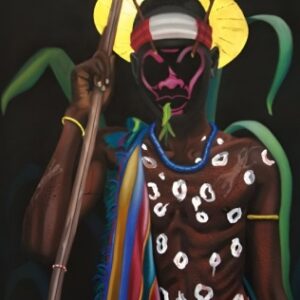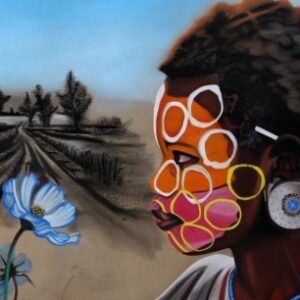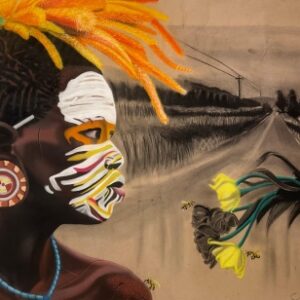
Cassius Khumalo
Cassius Khumalo is a Johannesburg-based South African Visual Artist, born on the 10th of November 1990. His professional practice ventures into studies of human evolution, multi-dimensionality, spirit, and universality. Paying attention to the process of how human beings are constantly moulding their world throughout their physical experience on earth. Guided by the premise that we mould ourselves with that which we believe in the most and that we are forever on a quest to understand the spiritual realm. This premise is not only limited to the individual but extends beyond. Sighting that at the core of every nation, every civilization, every religion is an identification with its spiritual magnanimity. Which catalyses shaping cultural perspectives and narratives.
Humanity’s quest for spiritual identity often encounters paradoxes and conflicts. Despite the equal and abundant nature of spirituality, the choices of representation and identification have led to divisions and confusion. This divergence arises when some deem their spiritual beliefs as more supreme than others.
The artist captures this complexity through four distinct series:
- God’s Face
- Deconstructive Faces and Figures
- Manhood
- Thandeka
Each series adopts a unique approach and perspective, addressing profound themes of identity, spirituality, and transformation.
1. God’s Face
For centuries, humanity has been preoccupied with embodying its God-self. Believing that humans resemble their creator, they have sought ways to connect with greater consciousness and remind themselves of this divine link.
The Role of the African Mask
In African traditions, masks were powerful spiritual symbols, acting as portals to the spirit world. When worn, they allowed the individual to transcend their physical self, embody a new identity, and channel divine messages. These masked identities were revered as manifestations of God, representing “God’s Face.”
Themes Explored in the Series
The God’s Face series revisits the African mask’s historical and spiritual relevance. It also explores other symbols of divinity, such as:
- The divine red and white beads commonly associated with South African spirituality.
- The face of a black child, symbolizing godlike innocence.
Through predominantly black chalk and dark tones, the artist reclaims the magic and beauty of blackness, celebrating African spirituality in its purest form.
2. Deconstructive Faces and Figures
This series delves into the process of transformation—how exposure to life experiences reshapes beliefs, identities, and perspectives.
Themes Explored
Transformation Through Exposure:
- Life introduces experiences that gradually deconstruct and reshape who we are.
- This transformation often leads to internal conflicts, misunderstandings, and new paths.
Questions Raised:
- What triggers these transformations?
- How do they impact identity?
- What can be done to find clarity amidst the change?
The series maps this journey of transformation, from the initial exposure to its lasting effects, revealing how seemingly insignificant events can create profound change.
3. Manhood
This series interrogates the evolving concept of masculinity, particularly in the context of African versus Western cultural perspectives.
Key Questions Explored
- What does masculinity mean for the traditional African man?
- How does the rise of fluidity in gender roles, influenced by Western culture, affect African masculinity?
- Is the traditional African male role at risk, and how does this impact family structures?
- Is there a healthy version of patriarchy within the African context?
The series offers a critical exploration of these themes, aiming to redefine and remember African masculinity in a rapidly changing world.
4. Thandeka
Inspired by the themes of the Deconstructive Faces and Figures series, Thandeka tells the story of a rural woman migrating to the city for a better life.
Themes Explored
Cultural Evolution and Identity Loss:
- Thandeka’s migration to the city leads to changes in her appearance, clothing, and morality.
- Over time, she loses connection with her cultural roots, forgetting teachings and clan names.
Adaptation and Transformation:
- Her evolution reflects the broader challenges of preserving identity amidst urban influences.





